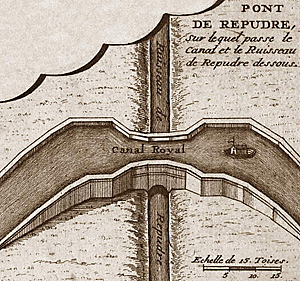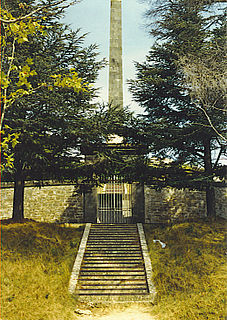The year 1679 in science and technology involved some significant events.

Riquet is a station of the Paris Métro. It was named after French engineer Pierre-Paul Riquet, who conceived and carried out the construction of the Canal du Midi from 1666. This work was completed by his sons in 1681.

François Andréossy (1633–1688) was a French engineer, cartographer, and a citizen of Narbonne. He was born in Paris on 10 June 1633. After completing his engineering studies in Paris, Andréossy went to Italy in 1660 to study Italian canal technology in Lombardy and Padua. He returned from the trip and sought out Pierre-Paul Riquet as a patron. Riquet was beginning his investigation into the possibility of building a canal across southern France from the Atlantic to the Mediterranean. Andréossy supplied the technical expertise that Riquet lacked and became Riquet's right-hand man throughout the construction of the canal.

Fonserannes Locks are a flight of staircase locks on the Canal du Midi near Béziers.

The Canal de Garonne, formerly known as Canal latéral à la Garonne, is a French canal dating from the mid-19th century which connects Toulouse to Castets-en-Dorthe. The remainder of the route to Bordeaux uses the river Garonne. It is the continuation of the Canal du Midi which connects the Mediterranean with Toulouse. Together they and the Garonne form the Canal des Deux Mers which connects the Mediterranean Sea to the Atlantic Ocean.

The Malpas tunnel was excavated in 1679 under the hill d'Ensérune in Hérault, allowing the passage of the Canal du Midi. It was Europe's first navigable canal tunnel and a monument to the determination of Pierre-Paul Riquet, the chief engineer. It is located in the commune of Nissan-lez-Ensérune. The Oppidum d'Ensérune is located on the surface a short distance from the tunnel.

There are 91 working locks on the Canal du Midi along its 240-kilometre (150 mi) course from the Bassin du Thau on the Mediterranean coast to the junction with the Canal lateral a la Garonne in Toulouse. There are a further 13 locks on the 37-kilometre (23 mi) La Nouvelle branch which runs through Narbonne to the Mediterranean at Port-la-Nouvelle. The locks are all under the management of the French navigation authority, Voies navigables de France.

The Bassin de Saint-Ferréol was created as the result of a large earth dam across the mouth of the valley of Laudot stream at St. Ferréol in the Montagne Noire. It was originally proposed by Chevalier de Clerville and accepted by Pierre Paul Riquet as an integral part of the Canal du Midi. Riquet needed to provide a sufficient water reservoir to allow the locks to function year round, even in the dry summer season. The dam was begun on 15 April 1667 and was completed in four years. It was the first dam built specifically to supply water to a navigable canal and was by far the greatest single work of civil engineering undertaken during the building of the Canal du Midi.

The Bassin de Naurouze is an octagonal holding tank, created during the building of the Canal du Midi as designed and built by Pierre-Paul Riquet. It was abandoned a few years after construction of the canal because of its recurrent silting problems. The flow of water from the Bassin de Saint-Ferréol joins the Canal du Midi at this point near the Seuil de Naurouze. Riquet hoped to build a city around the basin and also considered building a port. However, it easily filled with silt and its use discontinued. A lawn replaced the empty pool, and it is crossed by a straight path lined with plane trees.

Cesse Aqueduct is one of several aqueducts, or water bridge, created for the Canal du Midi. Originally, the canal crossed the Cesse on the level. Pierre-Paul Riquet, the original architect of the canal, had placed a curved dam 205 metres (673 ft) long and 9.10 metres (29.9 ft) high across the Cesse in order to collect water to make the crossing possible; the aqueduct replaced this dam.

The Répudre Aqueduct is the first aqueduct built on the Canal du Midi. Pierre-Paul Riquet designed it to cross the Répudre River. It was built by Emmanuel d'Estan. It was designed in 1675 and completed in 1676, but was severely damaged that winter and had to be rebuilt. It is one of three original aqueducts created by Pierre-Paul Riquet during the building of the canal from 1667 to 1681.
Louis Nicolas de Clerville, a.k.a. Chevalier de Clerville, held many military positions during his life in France in 1610–1677. He was associated with Pierre-Paul Riquet and the building of the Canal du Midi.
The rigole de la montagne was an important facet of the Canal du Midi, engineered by Pierre-Paul Riquet in southern France. The canal itself was built during 1666-1681. A critical aspect of the Canal du Midi was the supply of sufficient water to feed the canal. Each boat traversing its length would require a large quantity of water in the locks in order to climb or descend.

The critical feature of the Canal du Midi was to provide sufficient water to ensure that the lock system continued to function, even through the summer months. The first part of this endeavor was the rigole de la plaine. It carried water from the Sor River, at Pontcrouzet, to the Bassin de Naurouze, where the water was to enter the canal. This was done in 1667.
The Aiguille Aqueduct is one of several aqueducts on the Canal du Midi. In Puichéric France, it carries the canal over a small stream, the Rigole de l'Etang. It is one of three original aqueducts created by Pierre-Paul Riquet during the building of the canal from 1667 to 1681.
The Jouarres Aqueduct is one of several aqueducts on the Canal du Midi. In Jouarres le Vieux France, it carries the canal over a small stream. It is one of three original aqueducts created by Pierre-Paul Riquet during the building of the canal from 1667 to 1681.
The balancing of incoming and outgoing water allows the Canal du Midi to operate as it does. Each time a lock operates, large quantities of water are either required to fill it or dump from it into the lower level pound. There must be a constant source of water in order to fill and the excess water dumped must have a place to exit the canal without it overflowing. Being able to provide this water source was one of the most important problems to be solved by Pierre Paul Riquet, its creator.
















